The Dutch Know Beer
The Netherlands has a long standing beer history and the only non-Belgian Trappist brewery, La Trappe, to prove it. Beer culture in Holland manifests itself in many ways. From the behemoth Heineken, to the aforementioned Trappist brewery, and the ever burgeoning microbrew scene in between. Beer is to be found at most getogethers, festivals, and celebrations, as well as fine and low restaurants alike. Below I present some of my findings and explorations in this beer haven of a nation. I hope this sample entices you to grab a Dutch brew the next time you’re offered the chance.
Reuz Stout
It’s the beginning of June and I’m drinking a Reuz Stout. A barrel appears on the label but this version of the beer is not aged. However it does come in at a respectable 9.5% ABV. Predictably black, this good looking stout gives off hints of dark brown around the edges, and especially at the top of the glass. The smell is familiar to anyone who’s had a respectable stout and explored beyond Guinness.1 It is definitely sweet but by no means cloying, has a nice mouthfeel, and a light roasted touch. Smooth is definitely a word that comes to mind. When I suggest that it has a caramel flavor I have the Belgian doubles in mind and if not caramel then perhaps toffee.
Label source: ReuZ
Do not think that because I gravitate to the label so quickly I do not enjoy the beer but rather that I respect and appreciate the amount of information provided, as well as the detail and the display of the data. For instance, everything is clearly defined, from alcohol percentage, to storage temperature, as well as the glass and temperature it should be served in. Below that we have a different set of categories that provide us with diet details, number of calories, and IBU’s. One of my favorite things about European beer bottles are the prohibition symbols indicating who should not be drinking. For instance there is the silhouette of a pregnant lady in profile, an image of a car, and the number 18.2 Each of these is surrounded by a red circle with a slash across them, reminiscent of the Ghostbusters symbol, suggesting that we don’t want these ghosts.
It doesn’t take long, just a couple of sips and a little bit of reflection to realize that the well-hidden alcohol behind the delicious flavors is having its effect and once again I gravitate to the label. Now I’m attracted by the image and no longer care about the numbers and descriptions of the beer itself. On the front side of the label a giant reclines while drinking, there is a dwarf sitting on one of his knees, himself sitting and drinking. The giant looks merry, the dwarf the same, and I am happy to be in their company. Time for another sip.
A third of the way through the beer and with its continued warming the flavors begin to mature further. Additionally the mouth feel of the beer becomes more pronounced and leaves a fine, not unpleasant, coating. The beer is clean in its flavors, its aftertaste, and the lacing, or lack thereof, on the glass.
Again it is June here, the beginning of June. This means that it is not quite summer though the weather is showing signs of warming and has occasionally broken into the 80’s. So why am I drinking such a dark beer, a strong beer? For one, I enjoy the style. For another, this is not always the warmest place to be – I’m referring to the Netherlands of course.
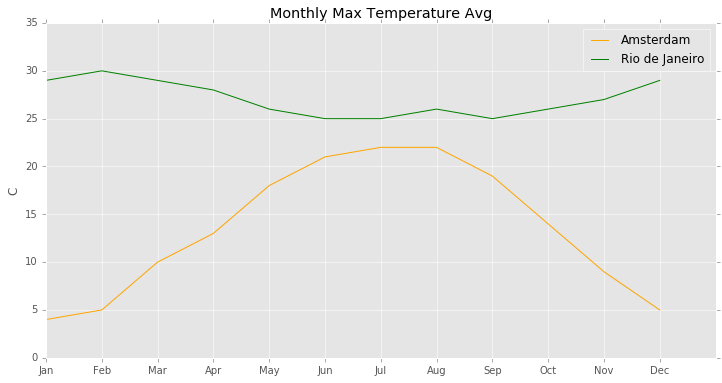
Data source: ClimaTemps
Punchline to above graphic of temperature comparison: for those of you who can’t make it to Rio for the Olympic Games, where it is incidentally now their winter, come right over to Amsterdam where the weather is basically the same. Except more overcast, more rain, and less total sunlight.
The upside to Holland not getting too hot is that I can more easily disregard (traditional) seasonal drinking and suit myself to the beers I wish to have in the moment.
I thought half of the six beers to profile would be dark and the other three of lighter styles. This would allow me to cover a wide range of styles in just one post. Whether that turns out to be the case may be determined by what state I’m in after drinking this 9.5% beer and my girlfriend finds me. It may very well turn out that I do a profile of one beer and five sparkling waters from the Netherlands. Damn giant and dwarf.
Dutch commentary: My first introduction to this beer was at a local cafe where this stout was nonchalantly listed on their menu. While in the Netherlands you may be presented with less draft choices than you’re used to at your regular US craft bar the NL bars make up for it with a wide bottle selection and an equally dazzling collection of matching glassware.
LOC & de 3 Horne’s Naughty Boy
[see update at end of this section]
Is it a stout, is it a BIPA? This collaboration from LOC and de 3 Horne is a bit of both. The photo shows the foam suggesting a Belgian-y yeast. The color and roast flavors say “stout”. The nose and forward flavor say “hops”. The label itself says a whole lot and nothing at all. Beside the cartoon we are provided a run-on sentence that was written under some type of influence and Google translate mashup.
“This brew was never meant to be, the recipe was never written and the ABV and IBU was never calculated. But this naughty boy wouldn’t listen, so from the second runnings of the LOC brewery Imperial Stout ‘84’ he became… If he is any good, well we dare not to say as this naughty boy is not to be trusted. Slightly toasted, malty flavor with a hint of savory together with the characteristics from the cascade and centennial hops.
Well just drink with mate!”

I’ve enjoyed this brew several times, both at home and at the bars, and I knew I’d include it among the selection.
Dutch commentary: Bars will rotate their bottles as likely, sometimes more often, than their draft choices.
I was obviously disappointed to find out that it is not as well received by most reviewers. I believe this is a result of possibly misplaced expectations. When I first drank it I wasn’t aware of the style and thought it a black IPA. Only after more closely reviewing and attempting to decipher the label, as well as visiting the brewery and beer review sites, did I see it was meant as a stout. I am going to argue this should be amended and I believe I have some data to back that up.
I pulled down ABV & IBU information on approximately 70 Dutch beers for three styles: IPA, BIPA, and stouts. This data was placed on a standardized scatter plot, with each point colored by beer style, and the surrounding areas receiving the color of the closest style. True to several of the LOC collaborations, Naughty Boy has its IBU numbers obscured so I created a vertical line for the 4.9% ABV that would represent all possible IBU’s on our current scale (see image below).
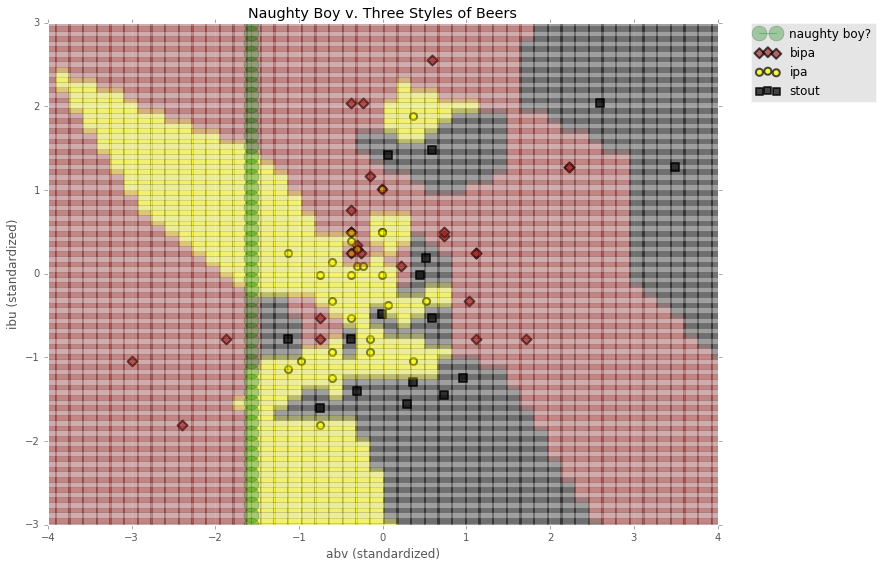
Data source: Untappd
Running a k-nearest neighbor analysis I discovered that for this limited data set (and yes, we should use more data) the best predictive returns would happen with two neighbors. Each of the candidate points above were then categorized by their two closest beer style neighbors and colored in based on scores. Naughty Boy occasionally receives a vote for “stout”, but never without a matching IPA or BIPA vote. In fact, the IPA and BIPA votes occur most often and are the two styles that present unanimous categorizations. Above a certain IBU, fifty-five, there are no votes for stout as a style.
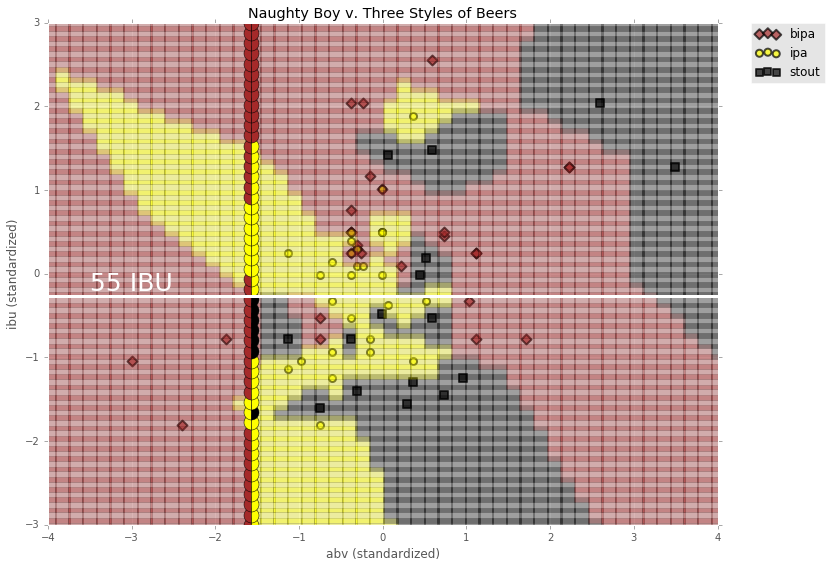
Data source: Untappd | Share Naughty Boy kNN
Quantitative analysis aside, of the fourteen top reviewers that rated this on RateBeer (Accessed: 24 July 2016) eleven mentioned “bitter”, and some more than once. Consumers naturally have predefined ideas about what they are getting into, including when they don’t know what to expect (which was a bit like my experience in drinking this without prior knowledge about the purported style). I believe the misplaced expectations of what a stout should taste like left reviewers surprised, and clearly not always in a pleasant way. I would submit that if Naughty Boy has an IBU of 55 or higher it be rebranded and possibly receive better reviews as a result.
[UPDATE - A couple of months after running this article I reached out to one of the breweries and received the following response: “First off we have to say that you are absolutely right and we actually regretted not dry hopping Naughty Boy and set the style to session BIPA. But then when brewing a collab you can’t precisely do as you want all the time.” - Daniel, LOC Brewery]
Emelisse Saison
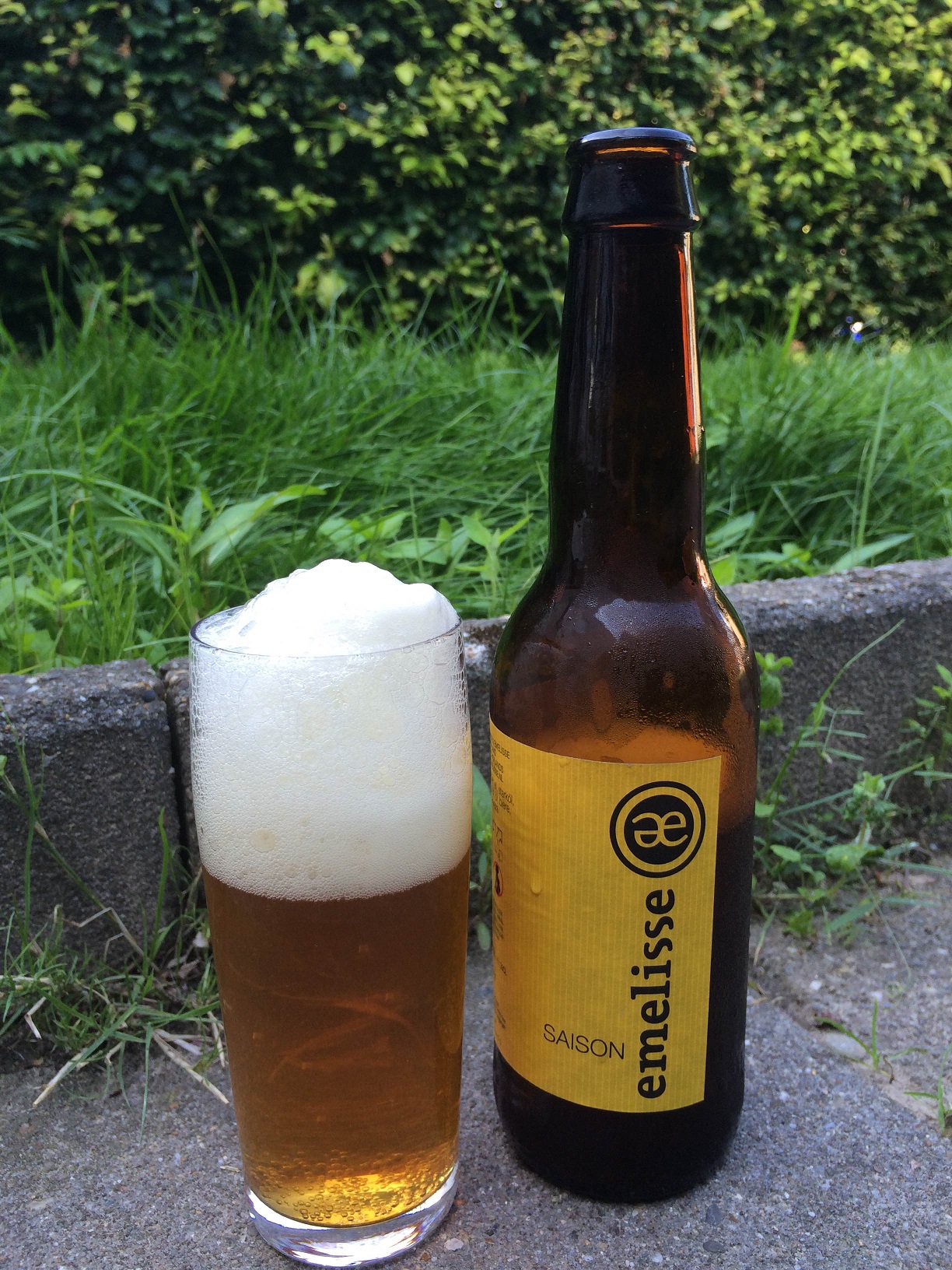
Emelisse is easily one of my favorite breweries from the Netherlands. For me it made sense to use them for a style that is not one of my go-to’s. Based on past (good) experiences with their beers I figured they would make this an offering I would like and give me an excuse to have another one of their style.
There are many things I enjoy about this brewery: of course first and foremost is the quality of the beers they make, beyond that is also the presentation. I’m not quite sure where you stand on the spectrum of accepting or denying the influences of marketing and packaging but I will not pretend that I am not swayed by its influence. The type and colors of the labels, yes we’re talking about labels again, are clean and easily recognizable on the shelf.
Dutch commentary: Excellent bottle shops are everywhere: across the border, next to supermarkets, in supermarkets. There’s a hazier line between craft and not here. Longer uninterrupted beer tradition, I suppose. Half of the beers covered here were picked up at a “beer shed” that casually also carries crates of Westvleteren 8, 10, & 12.
I decided to pour this beer into a small thin glass, perhaps thinking it would look better, and of course, it being a saison with the requisite yeast, I naturally got a lot of foam. I was on the lookout for this and avoided wasting a drop. I simply waited patiently until the foam subsided enough for me to pour more into the glass. I waited some more as it rose and then poured in still more. It’s been raining pretty heavily here for the last two weeks but as you can tell from the photo today is a sunny day, what better time to open up this beer.

Data source: ClimaTemps
While Amsterdam experiences 16+ hours of daylight during the summer, only about 7 of them are considered to be sunlight hours, the rest are obscured. New York and Los Angeles have less daylight summer hours, 15 & 14 respectively, but each gets more sunlight: 10 & 11 hours. From left to right: more daylight but lower ratio & absolute hours of sunlight to less daylight and higher ratio & absolute hours of sunlight. Verdict: move to LA.
This does not feel like a light beer. The label says 4.6% alcohol and it is certainly not something that’s going to knock you on your ass, but there is a full mouth feel, a light toffee, certainly malty, backbone which would easily lead you to believe that this could stand its own against many dishes, as Garrett Oliver mentions repeatedly for the style in The Brewmaster’s Table. While this is not my top style I’ve had my fair share and can say this is an enjoyable release. To recap: quick forming foam head, delicate nose, and light spices. Light orange body with many small bubbles on initial pour with a subsiding frenzy the longer it sits.
De Molen Rook & Vuur (Smoke & Fire)
I am a big fan of stout beers3 and definitely a fan of smoke beers, put them together for a winning combination. If done right. This last crucial detail turned out to be a point of contention on BeerAdvocate. A handful of people were definitely not impressed with the resulting combination from De Molen. Thankfully I did not fall into this camp. I anticipate at least benefitting from a shorter supply chain and lower risks of bottle shock. For me the combination was a success, so the camp I fell into should be pretty clear. I wanted to know if my description would bear this out so I took my review, in blue below, and ran it through some text analysis to see what BA reviews I matched up closest to.
This beer was bottled in January 2015 I am now enjoying it a year and half into its four year recommended window. The nose is what you would expect from a rauchbier. It pours enticingly dark with a thin head that does not build. There is still some carbonation within the bottle witnessed by bubbles casually drifting to the top. This beer is packing an expected punch in both alcohol and flavor. I definitely took the precaution of having a meal before, more for the flavor than the solid ABV (8.5%). It packs such a flavor punch that any food would have to accommodate itself to the beer, and not the other way around. Initially coming out of the bottle the smoke is most present in the nose and taste. However, as the beer warms and we continue to sip from it we begin to get the spicy tingle.
As it turned out my input matched well with positive reviews and confirmed my happy experience. I was definitively in the “solid” group and likely to score the beer 4 or above on each of its characteristics.
Parallel Coordinates for De Molen’s Rook & Vuur Characteristics
(grouped by IQR overall scores)
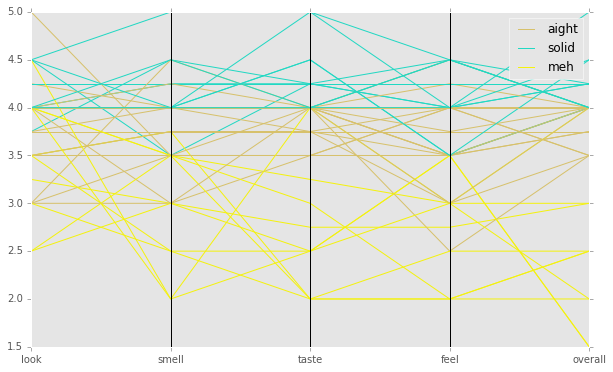
Data source: BeerAdvocate
Sticking with the label theme we have here another gorgeous one. So far we’ve had the goofy giant & dwarf of Reuz, Emelisse’s elegant and simple style, and the camp/kitsch of LOC’s Naughty Boy. I would characterize De Molen’s labels as “the essentials”. All the information and only the information is presented on the label. It looks not unlike what I imagine olde medicine did before radio, television, and that crazy thing young people call the world wide web.
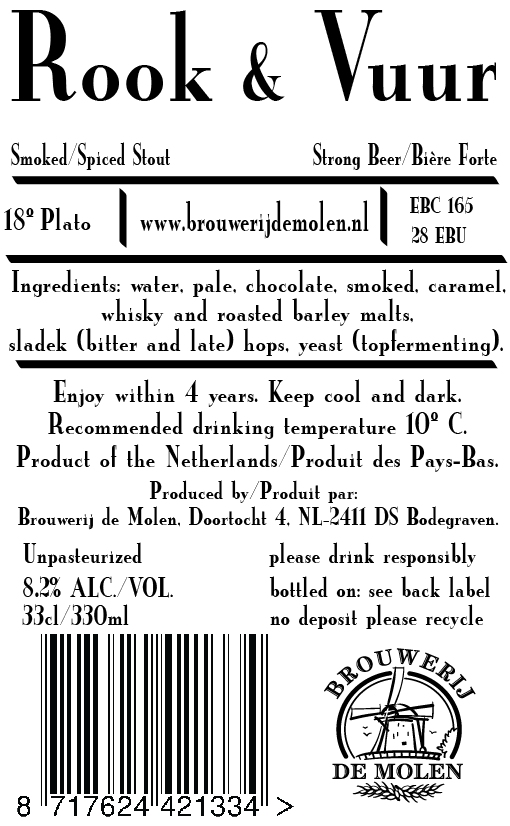
Label source: De Molen
Aside from the meal ahead of time I also made sure to make my lunch before I sat down to enjoy this brew. That’s another thing about the Dutch nearly all of them bring food to work and in an effort to fit in or at least not stick out too much I also do my best to brown bag it. I didn’t know how seriously to take the description of whiskey on the label yet as the beer settles in the glass I see what was meant and I can only wonder the type of lunch I would’ve packed if I had waited until after I have enjoyed this drink. It would have been night guy pulling a fast one on day guy. Alas I have decided to be responsibly irresponsible: my next day’s meal is prepared and I’m drinking on a school night.
After the initial build in spice the heat has not continued to escalate and as a result the beer does not become intolerable, far from it. I would not classify this as a primarily spicy beer but I can definitely see how it would be too much for people who do not appreciate a little kick. Hmmm, further sips suggest that on second thought you would at least need to enjoy spicy beers to appreciate this. Be forewarned.
Het Uiltje - Ransuil, Long eared owl (Oak aged Imperial/double stout)
Dutch commentary: You even get good beer in the department store! The first time I was introduced to this brewery was actually in HEMA. The idea of finding good beer in a department store is pretty alien to someone from the United States. But this is just one of the rough cultural differences I need to get used to if I’m going to make it here and be happy.
It’s been raining again most of the week, most of the month, most of the summer. Despite the long days much of it has been overcast and gray. It appears that my selection of beers fits right in to the weather theme of the summer, dark & stormy. So how about another stout, this one from Het Uiltje.
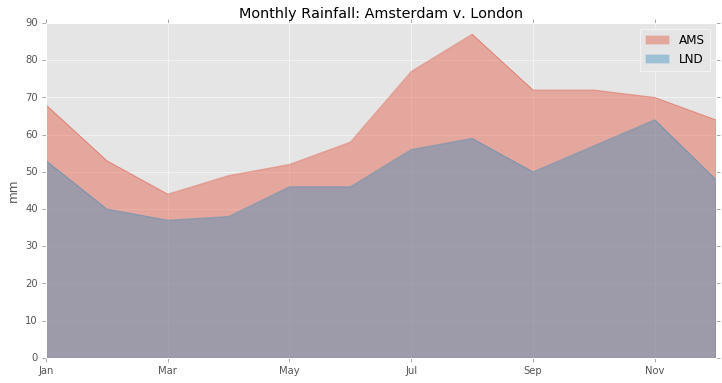
Data source: ClimaTemps
True to its label the beer has the distinctive oak-aged stout flavor. I prefer a Bourbon barrel aged stout but it’s nice to change it up and so they’ll be no objections from here. Unlike the other beers discussed in this post I have decided to pair this drink with some food. In case I end up not sharing the photo let me mention that it is cake. And I’m keeping it classy by not bothering with a plate, instead eating it directly from the tinfoil it was saved in.
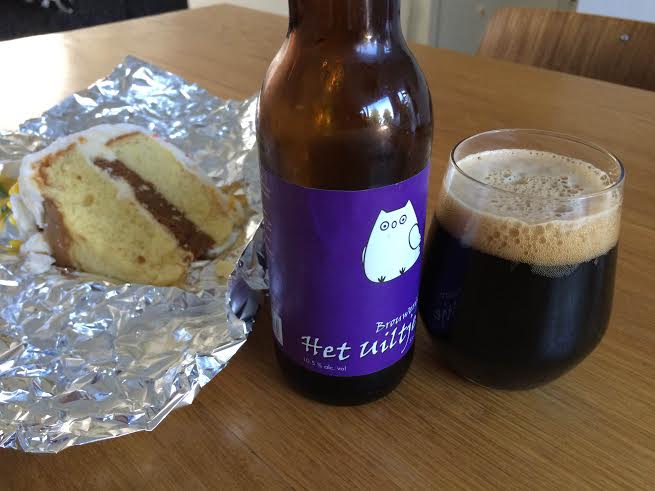
One of the reasons I prefer bourbon barrel to oak when aging a stout is the resulting flavor in the latter. For me oak seems to give the beer a somewhat leathery or musky aroma. I’m not sure if that description of the smell is quite accurate. Though I can often recognize the flavors present in beers it is sometimes difficult to put the accurate labels on them. It is something akin to flavor deja vu. An occupational hazard I suppose. I’ll have to look into how other people describe this perceived phenomenon so that I can make my slight objection (after all) a bit more refined and pointed.
Dutch commentary (cont.): Back to the department store, I was understandably a bit resistant to the idea of purchasing beer when I saw it stacked alongside other knickknacks such as socks and stationary. However two things swayed me towards making the purchase. First was the style: black IPA. Second: the price. I mean who doesn’t like a good deal and if the product turns out to be halfway decent even better, right?
Enough with all that, how about the beer? Smooth of course, very clean, solid mouth feel, and not at all watery. Has a serious 10.5 punch that is quite sneaky. You don’t taste the strength but it is there lurking if you’re not paying attention. The label, how long did you think I would go without mentioning that, refers to the hoppiness but I have to be honest I don’t get too much of that yet it needs to be graded on a curve and for a double/Imperial Stout I can see that it does contain a nice hoppy-ness.
Dutch commentary (cont., II): So how did the purchase from HEMA go? Quite well, not only was I introduced to the black IPA from Het Uiltje but also a Thai spice triple from Oedipus. Both delicious. Don’t hesitate to grab a beer with your next purchase of socks the next time you’re in a Dutch department store.
‘t IJ - IPA
We are now at the end, the final beer, and it is bittersweet. Not only the selection, IPA, but also the way it’s been received and rated by others. I wanted to say last but not least, unfortunately both last and least seems to be how many people have come to appreciate the IPA from ‘t IJ. It’s a shame for me personally since this is one of the first beers that made me realize that in a land with so much traditional brewing there was definitely a craft beer scene, and a damn good one at that.
Perhaps I am too lenient and overly forgiving in my appreciation. I would likely be the bizarro-Russian judge when it came to scoring performances. Nevertheless, what we have here, at least in my opinion, is a damn solid IPA. Light orange in color, light and fluffy white foam, with inviting floral notes. When it comes to criticism I must admit that I have found this beer to be a tad inconsistent, perhaps something to do with the bottling and or distribution. This is unfortunate in such a crowded market where it is rare to get a second chance to change someone’s mind, especially if they do not often have an opportunity to come across your beer again. This certainly makes quality job one.
Dutch commentary: Price is one of the small beer adjustments I have had to make. Similar to back home, beers are cheaper at a store than at the bar but the price difference is not nearly as great as what I’m accustomed to and as a result I often feel I’m getting a better deal at a bar, even with the higher price because of the larger selection than what I tend to keep at home. Chalk it up to predictably irrational human perception. All in all prices are cheaper here than back in New York, there are few places that would not be true, both at the bar and at the bottle shops. The difference is that the bars tend to charge quite a bit less than in the city but the bottle shops don’t provide much of a discount at all (again to what I’ve become accustomed to). As a result, and since things are relative, I tend to appreciate the bar prices a bit more.
My original thoughts after the first time enjoying4 ‘t IJ’s IPA was that it was a solid beer that might be a fair substitute for my beloved Lagunitas IPA. I do not pretend to claim that Lagunitas makes the greatest IPA in the world but I would be happy with it on almost all occasions. Simply put, Lagunitas IPA is a fantastic everyday beer. After my investigations I found out that I might not have been too far off in equating the two, as both beers were far less favored than I would have anticipated.
With my original sanguine ideas in mind I collected ratings for ‘t IJ and several other American IPA’s with the intent of comparing user ratings and getting an idea of head-to-head preferences.5 I found users who had rated 2 or more of the selected IPA’s and used their ratings as voting proxies. Beers with the same score by user received half a vote a piece, otherwise the higher score would determine the winning/preferred beer. In total there were 3,950 reviewers that constituted 31,852 head-to-head matchups. By tallying the “votes” and splitting by total “ballots” cast in matchups I was able to generate a user ratings table:

Data source: RateBeer
The table indicates by what percentage users prefered the beers listed on the left (y-axis) over the beers along the bottom (x-axis). For example, users preferred Bells to Stone 59% of the time.
I next used the above numbers to run a maximum likelihood process that would determine the overall rating of each beer, based on these preferences/wins, and provide an expected win rate against all other beers listed. Once again, the table indicates the likelihood of preference by beers listed on the left (y-axis) over the beers along the bottom (x-axis).
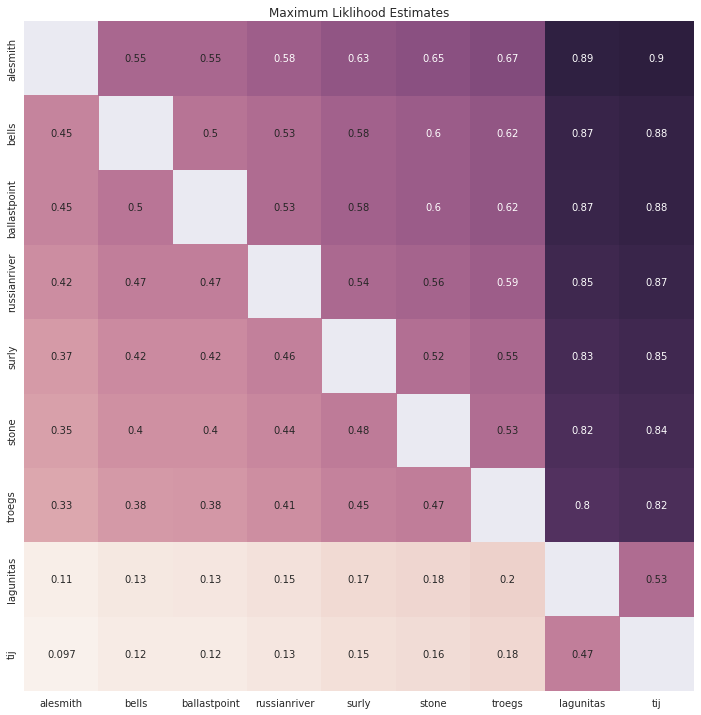
Data source: RateBeer
There’s been some movement, but not much. Needless to say I was unpleasantly surprised to see BOTH Lagunitas and ‘t IJ rating so low. A further look at ABV and IBU do not hint at much, maybe showing a preference for higher IBU’s but Bell’s doesn’t seem to suffer from this.
| Beer | ABV | IBU | Rating |
|---|---|---|---|
| alesmith_ipa | 7.25 | 73 | 1.61 |
| bells_twohearted | 7 | 55 | 1.3 |
| ballastpoint_sculpin | 7 | 70 | 1.3 |
| russianriver_blindpig | 6.1 | 70 | 1.14 |
| surly_furious | 6.6 | 100 | 0.96 |
| stone_ipa | 6.9 | 77 | 0.88 |
| troegs_nuggetnectar | 7.5 | 93 | 0.79 |
| lagunitas_ipa | 6.2 | 46 | 0.2 |
| tij_ipa | 7 | 60 | 0.17 |
This may be a long shot but I’m assuming the label is bringing up other desires in drinkers that unfortunately cloud their reception of this brew. If you see someone playing with a piece of paper or tearing a label off of a jar, it is not uncommon in the US to joke that they are sexually frustrated. Maybe a label change would refocus drinkers to what they have in hand and not what they’re missing out on.
Image source: ‘t IJ
Notes
1 No disrespect to Guinness. It’s just that there’s more to stouts than Irish stouts, is all. ↩
2 The latter two are not present on the label image off of the brewery website but do appear on my version. In real life. ↩
3 Clearly, based on the choice of beers in this piece. ↩
4 Yes, enjoying it picky beer snobs. ↩
5 Original motivation/inspiration from this fivethirtyeight piece;
step-by-step method at pro-football. ↩